Sarah and DASH! both faltered on the same day, back in February. It was a Saturday. Our regular vet was closed. Our back up vet was booked solid. Both ER’s had busy waiting rooms, both ER vets in emergency surgeries, and the estimated wait times were at least 2-3 hours.
Let’s all sing the Happy Happy Joy Joy song, shall we?
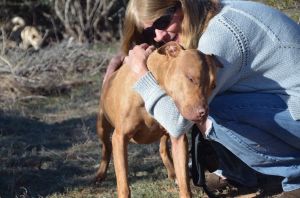
In the case of Sarah, we’d been there, done that, on many occasions. We’ve gotten so good at home treatment, and in her condition, she wasn’t even a consideration for an ER visit at the time.
DASH! was another story altogether. Rather than stress him further in a crowded ER waiting room, for who knows how long, I decided to test what we’ve been rehearsing at home, while periodically calling the ERs to check on wait times.
I’ve gotten several phone calls and e-mails of late, concerning dogs in similar circumstances, and figured maybe I should write about what we do in case someone outside personal contact might find it of use.
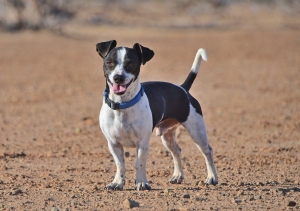
DEHYDRATION HAS MANY CAUSES, AND IT IS NOT SOMETHING TO MESS WITH. 10% dehydration is enough to kill a dog. If you are facing your first dehydrated dog, read no further and go immediately to your vet. It’s incredibly important that you observe the effects of dehydration, as well as signs given by the dog that he or she is or isn’t rehydrating. If you don’t know what you’re watching for, or know when things are going from bad to worse, you are risking your dog’s life.
How do we know what we know? Sarah.
As I’ve mentioned before, Sarah blesses us from time to time with bouts of uncontrollable regurgitation. Regurgitation is different from vomiting – look them up to learn the difference. Back in the beginning, Sarah would be admitted to the hospital on IV fluids. As time progressed, we learned a few tricks to avoid those costly visits.
If Sarah starts an episode in the middle of the night, or while we’re at work, chances are, by the time we get up, or get home, she is in need of sub-q fluids, in addition to our little routine which I will describe here shortly.
To tell just how bad off Sarah is, I grab some skin at the back of her neck and pull it up. If it doesn’t even try to snap back at all, or snaps back very slowly, we immediately go to the vet for sub-q fluids. This does not require hospitalization. We then take her home and begin At Home Rehydration.
If her skin snaps back slowly (as opposed to very slowly), we still have time, and I start the aforementioned Procedure.
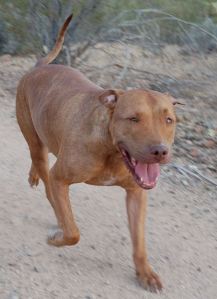
If we happen to be home and catch the ‘episode’ when it starts, we go straight to At Home Rehydration because even at the first time Sarah regurgitates, she is already dehydrated, just not seriously so. At this point, if I pull her scruff skin up, it flattens out slower than when she is hydrated.
Please note: We have learned where the thresh hold is as to where we can treat Sarah at home vs. the need to take her to the vet. It’s not guess work, it’s that we know Sarah and how she responds. We don’t take chances with our girl.
OK Everyone: Stop reading now and do the scruff test on your dog. Learn what normal is so you don’t have to wonder later. Do this occasionally, and forever, so you can learn what is normal for your dog. We caught Sarah once, when we didn’t see her regurgitate, far along in her dehydration, just from a random scruff test. There’s also an indicator from a dog’s gums, but I’ll leave that between you and your vet.
When Sarah used to go in for IV Fluids, she would receive between 1000 and 1500 ml over a period of 8-12 hours. This calculates to approximately 4-6.35 cups. Please read again the volume and the time frame it was administered. Rehydration is a SLOW process. If you try what I’m about to describe, but rush it, you will cause more harm than good.
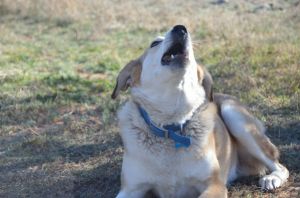
Since Sarah’s regurgitation episodes are sporadic, and each one requires intervention to rehydrate her, we started practicing between episodes to get her to drink when we want her to. Yup, we trained her to drink on command.
I would put a dollop of her most favorite food, a pretty wide selection for Sarah, at the bottom of a bowl, and fill the bowl with water. She would drink to get the food. We got her to the point of knowing, if ever a bowl of water was deliberately presented to her, it meant something good. We conditioned her to drink when we asked. Even a sick dog will follow commands – drinking is the only command Sarah, and the others, for the most part, has ever been asked to obey.
Now let’s fast forward to the day she and DASH! woke up dehydrated:
I dropped a very small dollop of Vito’s home made food in 1/4 cup of water and gave it to Sarah. Of course she slurped it. She’s been conditioned to do so. Only 1/4 cup – we didn’t want her to overdo it and throw it up. As a reference, Sarah is 70 pounds.
An hour later, same thing, 1/4 cup.
The next hour, same thing, 1/2 cup.
The next hour, same thing, 1/2 cup.
Notice the trend? Very small amounts, an hour apart. We have to make sure it stays down. If Sarah had vomited or regurgitated after a drink, (she didn’t do it this time, incidentally) we would try again in a few minutes, offering a lesser amount of water. We want her to drink , and give her body time to absorb the water before giving her more. Too much, too fast, even if Sarah didn’t vomit it up, can shock her system and cause more problems.
At the 4th hour, we increased it to 3/4 cup, but moved it to 2 hours apart.
This is Sarah when she was up to a cup, every 2 hours. (Note it’s dark outside – this was an all day and into the night process. ) We did not feed her that day, other than the small amount of ‘bait food’ at the bottom of the bowl. We needed her stomach settled, and fluids were more important than food. Her scruff had already been snapping back normally for a few hours. Still, we kept up the drinking into the next day. She was also fed a small and very wet breakfast the next morning.
I put a little Pedialyte in the water. Pedialyte provides electrolytes for human children. I learned recently that even performance dogs don’t require electrolytes as they don’t lose minerals (through sweat) like people do. In the future, I’ll just skip the Pedialyte since it serves no purpose.
OK, that’s Sarah. What about DASH!? It appeared he got a hold of something in the yard that made him very sick. He had vomited all over the house (caused his dehydration) throughout the night. Our first thought was a potential obstruction. Unfortunately, both ER vets were already in emergency surgeries with other dogs. There would be no immediate attention for DASH!, even if an obstruction was found, for some time. Our best bet at that point was to keep him calm, and hydrate him until a vet was available.
DASH! is our problem child. We can’t coax him into doing anything he doesn’t want to do. But he does have one quality about him: He’s pretty selfish, and we use that to our advantage. If we want him to eat something or do something he doesn’t want to do, we use another dog to make him do it, and that includes drinking. Know your dog, know how to get him to do things he doesn’t want to do, even if he doesn’t feel well.
Turns out, all our practice paid off!
This video was taken later that evening. Unlike Sarah, who would drink on her own, DASH! would only drink if he thought a sibling wanted what was in the bowl. The bait food in the bowl was not for DASH!‘s benefit, but for the benefit of whoever we used to make DASH! think wanted it more. Yes, we tormented Hector, Franky, and Vito throughout the day, for the sake of their brother’s health. A necessary evil, but the boys were rewarded for their efforts.
Like Sarah, DASH! received very small amounts – in his case, we started at a tablespoon of water, working up to 1/4 cup – all day. By the time this video was taken, he was already re-hydrated, but we continued making him drink, until bed time, then I got up twice in the night to do it again. He also received a smidgen of pumpkin, but also had a Peanut Butter Run A Munchie, his favorite food, crumbled in the water. We did not feed him that day (fluids more important than food). The next morning, he had a very small, wet breakfast.
_____________________________
KEY POINTS TO REMEMBER!!!!
1. Practice while your dog is healthy. Condition him or her to drink. If you wait until your dog is sick, you are left with a sick dog who won’t drink. If you have to be creative (like we are with DASH!), figure it out before you need it.
2. Re-hydration does not mean get as many fluids down as quickly as possible. Too much too soon can lead to vomiting, and yet further dehydration. Too much water too soon, if not thrown up, can shock the dog’s system and cause more harm than good. The key is small amounts given at regular intervals.
A little math for you to keep in mind:
A 1 Liter IV bag is equivalent to 4.23 cups
The last time Sarah (70 pounds) was hospitalized for IV fluids she received 1500 ml (1.5 L) over a period of 12 hours. This equates to approximately 6.35 cups – again over 12 hours.
GO SLOW! I can’t stress that enough.
3. If your dogs does not drink, and you can’t get him to drink within a couple hours, go to the vet immediately.
4. If your dog drinks but throws up repeatedly, no matter how little you give him, go to the vet immediately.
5. If your dog does drink, but does not urinate (within 8-12 hours), or strains to urinate, go to the vet immediately.
6. If your dog drinks, but refuses to eat, and this continues to the second day, go to the vet immediately.
7. If you have second thoughts or get nervous when you try to rehydrate at home, go to the vet immediately.
8. These little tricks are not a replacement for vet care. It wasn’t until mid afternoon that I stopped calling the ERs for wait times for DASH! . If there was an empty waiting room at either facility at any time during my earlier calls, I would have taken him in, despite the fact he was drinking. But he had had a normal bowel movement, was urinating, and had not vomited since early morning. I knew we were out of the proverbial woods, and a vet visit was not necessary at that point. With 12 dogs, we’ve been around the block a few times. We know when we can intervene and we know when not to be too proud. The ultimate goal at all times is the health and happiness of The Hoard. It doesn’t matter who gets us to that point, it only matters that we get there.


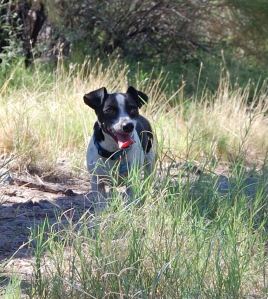
Kali said she gave DASH! her phone number. 1-800-K9N-URSE.
Love it!
You seem to be having a share of problems right now ( Hi there Willie!) I did the scruff test and my babies are fine but the little man is getting very unsteady on his back legs – his falling is hurting me more than it seems to bother him.
Sometimes it’s hard to watch them grow old 😦 I know what you mean. Sarah’s stumbling seems to bother me more than her!
I stopped reading and did the scruff test, seems Easy is fine :o) Many thanks for the tip :o) I always wonder why such things happen either at night or on weekend….
Check it a few times here and there so you know what normal is!
I check both boys after walks this time of year also…a scruff test on Clyde is easy….with Lucky I also check gums to be sure as with his thick
coat it is harder to get a reading with a scruff test
I was a little hesitant to mention what to look for on the gums since gums tell many things. Great that your vet showed you what to look for!
I can get a little dehydrated if my colitis flares up or I throw up (usually something delicious that I ate when I shouldn’t have). I know the “drink” command but it only really works if I am thirsty. BUT… there’s a stash of chicken juice ice cubes in the freezer and I get one every hour or 2 if I have colitis just to keep me hydrated. Didn’t know about the scruff test though!